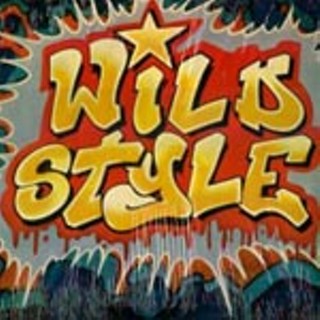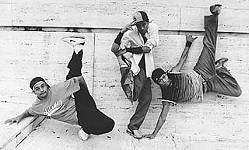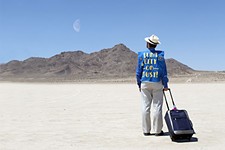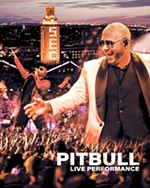Down by Law
More than two decades later, 'Wild Style' still stands as a hip-hop high point
By Robert Gabriel, Fri., June 11, 2004

Known as one of the cornerstones of the emerging hip-hop movement of the early Eighties, Wild Style presented rap music, breakdancing, and graffiti as a cohesive culture and valid art form born of the streets of New York's South Bronx borough. Director and writer Charlie Ahearn is still as enthusiastic about his cinematic masterpiece as he was upon its initial release in 1982.
Austin Chronicle: How did you end up working on Wild Style?
Charlie Ahearn: In 1980, I had been working on what I would call a ghetto art movie called Deadly Art of Survival in the same neighborhood where Lee Quinones lived. There were these large handball courts there, which at the time I considered to be some of the most exciting art in NYC. I would ask the kids in the neighborhood who did them and they would just shrug. "Lee ... of course." Apparently, Lee had a reputation as being mysterious and hard to find. I put the word out that I was interested in working with Lee, and, sure enough, one day while we were shooting, this skinny guy with a big afro rolled up on a motor scooter, introduced himself, but then disappeared about as fast as he arrived. At that time, Fred Braithwaite [aka Fab 5 Freddy] was already working with Lee to organize a showing of graffiti paintings in Italy. Upon seeing fliers for my film posted up in project neighborhoods, Fred came to a show of mine in Times Square and presented to me his idea of making a film that would combine graffiti with rap music. After mentioning that he was in contact with Lee, I told him that if he could get Lee to come down the next day to work on a mural that I would pay for all of the supplies. Fred and Lee complied, and that's when the three of us started talking about how we would do the movie.

AC: Was it your intention for Wild Style to take on the characteristics of a documentary, as it has assumed over the years?
CA: It wasn't my intention to do a documentary at all. Documentaries have become fashionable since, but back then, documentaries were what I considered to be stuffed, as in a stuffed shirt. What I wanted to do was something for the kids on 42nd Street, which is where everyone would go to watch kung fu movies. The model for my film was based off of Bruce Lee movies and a bit of The Harder They Come. Of course, Wild Style does indeed document a moment in time, but what I was really trying to make was a performance film where everyone would get their five minutes without being bogged down by a typical Hollywood narrative.
AC: Did you get the impression at the time that hip-hop culture was specific to the South Bronx, or was it happening elsewhere as well?
CA: Graffiti was always citywide from 1970 on. So, the idea to center the amphitheatre scene in Times Square was intentionally done to draw people from all boroughs. But I did come to understand that in regards to rap music that the Bronx was the motherland. By working on Wild Style, I got deeply involved in a lucky way with one of the true birthplaces. According to which DJ you aligned yourself with, the Bronx was split into three camps. Kool Herc held down the northwest, Afrika Bambaataa the southeast, and Grandmaster Flash the center. Since Fred and I were interested in portraying rap rooted in the fat bass drum sound of James Brown, we naturally gravitated toward the realms of Grandmaster Flash. When the film initially came out, it actually got dissed for being a bit old-fashioned in comparison to the electro sounds of Bambaataa.

AC: What about the process of recording the soundtrack?
CA: As a producer, I was afraid that I would shoot MCs performing and then would have record companies wanting to be paid for footage that had their songs in the background. So, we came up with a plan to record an album of original break beats. Fred was friends with Chris Stein, who let us use his studio. We brought Lenny Ferari in to do drums and wound up doing the whole thing in a matter of hours. We pressed up 50 copies of the record, which were then distributed as doubles to all of the DJs involved. Since we did this up front, the deejays then had about a month to test out the music in clubs before we actually started shooting the music scenes.
AC: I've read that you had to reshoot the club and amphitheatre scenes. What were they like the first time around?
CA: The first time around we used the Cold Crush sound system, which wound up being overmodulated. The experience really helped me clarify the way to do it right. The first time around, we also had Grandmaster Flash and the Furious 5 on stage as the headliners. But between shootings the group broke up. The second time around we also decided to go ahead and put the Rock Steady Crew right on stage with the MCs and DJs. The first time around, they were merely off to the side. That was the first time that anyone had ever known breakdancers to be a part of a stage performance. In fact, the entire time that I spent in the Bronx, I never witnessed anyone breakdancing. By that time it was basically an outdated mode of artistry. There was a whole generation of B-boys who came and went before hip-hop was ever even noticed.

AC: Did you notice any backlash in the Bronx at that time in regard to Sugarhill Gang's "Rapper's Delight" being hip-hop's first hit, even though it was done by outsiders?
CA: It was absolutely central to my own involvement with the scene. When "Rapper's Delight" came out, everyone in the Bronx felt burned. Since I came from a different angle than the record companies, as an independent filmmaker on foot in the neighborhoods, people wanted to get involved because they didn't want to be left out again.
AC: Could you talk a bit about the theme of an outlaw culture being compromised in order to achieve commercial success?
CA: Lee crystallized all of the conflicts there were within graffiti at the time. He was definitely ahead of the pack as the most famous underground legend on the subways, who had already – for six months to a year before we started shooting – been showing paintings in galleries. So, more so than anyone at the time, he was living the contradictions. The first day that he showed up to shoot, he arrived with all of this heavy pancake make-up on his nose. When I asked him why, he responded that he didn't want the cops to recognize him. Lee even refused to show up to the trainyard, even though we paid for the honor of being there legally, which is why we had to use DONDI to fill in for him. It was all very scary for Lee, who felt he was moving into quasi-religious territory.
AC: So the film is probably more realistic than people think?
CA: Let's just say that I didn't have to go very far to find the story. I actually had Lee extemporize many of his true feelings into monologue. Even just to get him to star in the film, I had to threaten him with the prospect of casting his real on-and-off girlfriend Sandra "PINK" Fabara as the lead character, which would entail her kissing another guy. I was basically inspired by the way that Andy Warhol would cast these really wild real-life characters into his films, only to let their strange interactions become the theme of his movies. ![]()
Wild Style screens as part of the Texas Documentary Tour, in conjunction with B-Boy City 11, on Friday, June 11, 9:45pm and 11:49pm, at the Alamo Drafthouse Downtown (409 Colorado). Charlie Ahearn will conduct a Q&A after the screenings. Tickets are $10. They are available only through the Alamo Drafthouse. For more information, call 472-1320 or check www.drafthouse.com. For More on B-Boy City 11, see Music Recommended.











